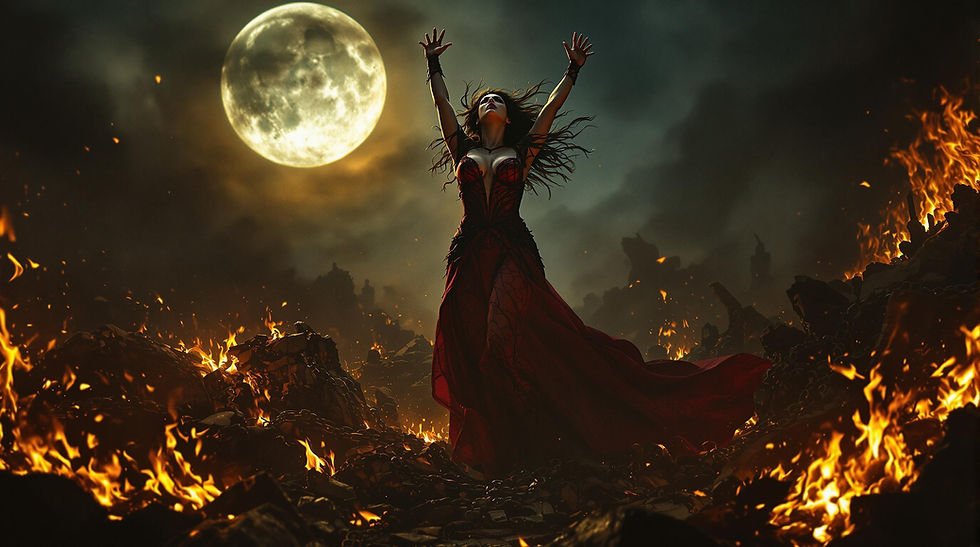Bhoot Bangla Burned Down, We Stayed
- Sapna Moti Bhavnani

- May 15
- 3 min read
Updated: May 29
by Sapna Moti Bhavnani

India doesn’t have a horror tradition, they say. No sci-fi. No fantasy. Just songs, family drama, and reincarnation romances. Maybe the occasional ghost in white, provided she’s quiet, sexy, and dead by the second act.
But yet
This country is haunted by everything— ancestors, partition, dowry deaths, gendered violence, child marriages, mother-in-laws and the worst of them all WhatsApp forwards. Fear runs through our bloodlines. Our grandmothers told stories with teeth. Our lullabies were basically cautionary tales with better PR.
We didn’t need jump scares. We lived them.
And yet, when it comes to cinema, genre has been treated like that untamed cousin nobody invites to dinner. Horror, especially, has been stuck in the basement. The Ramsay Brothers ruled the ’70s through the ’90s with their formula: one graveyard, one cleavage, one man in a monster mask. Shot in a week, edited on the go, and sold through lurid posters. It was pulp, yes—but it worked. Because no one else was even trying.
Ram Gopal Varma broke the cycle for a minute with Raat and Bhoot. For the first time, horror felt atmospheric, psychological, urban. But Bollywood, in its comfort zone of family sagas and item songs, never committed. Horror remained the outsider.
More recently, women have started claiming space, and it’s about time. Anushka Sharma’s Pari used horror to talk about trauma and religious extremism. It wasn’t perfect, but it was political. Anvita Dutt’s Bulbbul reimagined the chudail as a woman wronged, wronged again, and finally, in charge. Of course, critics called it “too pretty,” as if women aren’t allowed style and substance in the same frame.
The Southern film industries have been bolder with genre. Eega gave us a revenge drama with a housefly protagonist—and made it work. Pizza started as a horror story and flipped into a thriller halfway through. Kantara tapped into local lore and ritual possession. But even in these more daring spaces, women remain mostly ornamental—mothers, lovers, victims, rarely the ones driving the plot or the camera.
Fantasy in India leans heavily into testosterone. Think Baahubali, PS-1, Magadheera. Epic battles, divine men, vengeance with six-packs. But where are the magical women who aren’t just sidekicks or witches? Where are the queers, the lower castes, the misfits? Why does fantasy only serve power when it could dismantle it?
Science fiction is even rarer. We still talk about Mr. India like it came out last year. Rajinikanth’s Enthiran and 2.0 flirted with AI and climate change but were ultimately Rajini spectacles. Arati Kadav’s Cargo was the exception—a lo-fi, retro-future meditation on death bureaucracy and loneliness. Made on scraps and spirit, it didn’t need Hollywood polish. It was desi, dark, and deeply original.
Then there’s Tumbbad, hailed as a genre gamechanger. And it is—a folk-horror epic with staggering visuals and a story soaked in greed. But not a single woman in its writing or direction team.
Which brings us to the real horror: invisibility.
It’s not that women don’t want to make horror, sci-fi, or fantasy. Of course we do. Who better to conjure fear, bend time, or tear open reality? But genre demands risk, time, money—and those aren’t currencies we’re easily handed.
I’m so tired of attending festivals and sitting through panels about the absence of women in genre—often delivered with practiced remorse by women whose entire careers have been built funding men. Look around – WE ARE HERE!
We’re allowed to be muses, not monsters. We can cry, but we can’t haunt. We can dance in the dream sequence, but fuck if we build the dream. And yet, women have always told genre stories. We just told them in kitchens, in whispers, in lullabies, in bathroom stalls, in diary margins. We told them with our bodies, our blood, our rage. We told them when nobody was listening. Now we’re saying it louder.
Horror isn’t a gimmick. It’s a language. Sci-fi isn’t escapism. It’s prophecy. Fantasy isn’t fluff. It’s freedom. And women aren’t just ready for it—we are it.
I did not make it to Cannes but my work did! Stoked to have this published in the official MIFF magazine!












Comments